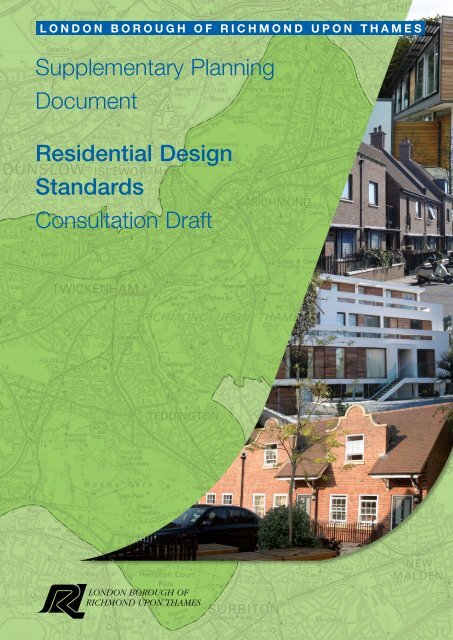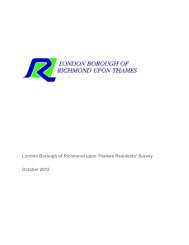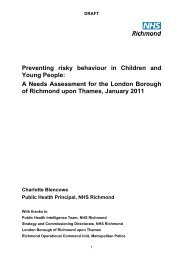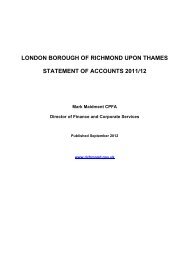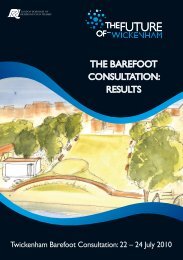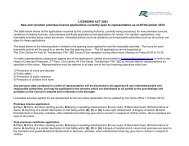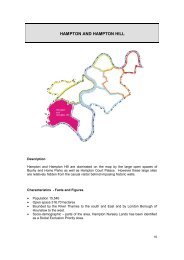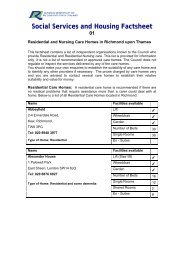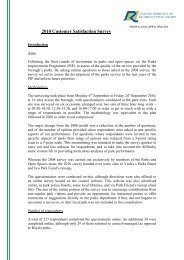Residential design standard - London Borough of Richmond upon ...
Residential design standard - London Borough of Richmond upon ...
Residential design standard - London Borough of Richmond upon ...
You also want an ePaper? Increase the reach of your titles
YUMPU automatically turns print PDFs into web optimized ePapers that Google loves.
Supplementary Planning<br />
Document<br />
<strong>Residential</strong> Design<br />
Standards<br />
Consultation Draft
If you need this leaflet in Braille, <br />
large print, audio tape,<br />
or another language, <br />
please contact us on <br />
020 8891 7322<br />
or minicom 020 8831 6001<br />
Albanian<br />
Arabic<br />
Bengali<br />
Farsi<br />
Gujarati<br />
Punjabi<br />
Urdu
Contents <br />
Chapter<br />
Page<br />
1 Introduction 2 <br />
2 General principles 3 <br />
RESIDENTIAL AMENITY STANDARDS <br />
3 Neighbourliness 4 <br />
4 Privacy and space between buildings 5 <br />
RESIDENTIAL SPACE STANDARDS <br />
5 Garden and play space 6 <br />
6 Internal space and layout 8 <br />
7 Parking 11 <br />
DESIGN GUIDANCE FOR HOUSEHOLD EXTENSIONS <br />
8 Front and side extensions 12 <br />
9 Rear extensions and outbuildings 14 <br />
10 Light wells and basements 15 <br />
11 Garages 15 <br />
12 Ro<strong>of</strong>s 16 <br />
13 Sustainable <strong>design</strong> 19 <br />
14 Checklist for homeowners 21 <br />
Further information<br />
22 <br />
1
1 Introduction<br />
1.1 This guidance is indicative <strong>of</strong> the Council’s general approach on this subject and is<br />
not intended to stifle sensitive and imaginative <strong>design</strong>. Because <strong>of</strong> the diversity in<br />
residential character, house type and architectural style within the <strong>Borough</strong>, it is<br />
neither possible nor desirable to cover every type <strong>of</strong> change or eventuality for new<br />
residential development.<br />
1.2 With listed buildings greater care and attention is required. More restrictive policies<br />
will apply and Listed Building Consent may be required so please contact the Council<br />
for further advice. Where necessary in this document, additional <strong>design</strong> guidance is<br />
highlighted for conservation areas and historic buildings (both Listed Buildings<br />
and Buildings <strong>of</strong> Townscape Merit) applies to listed buildings.<br />
Status <strong>of</strong> document<br />
1.3 This Supplementary Planning Document (SPD) is for homeowners, architects and<br />
builders undertaking residential development or works to residential dwellings, and<br />
for <strong>of</strong>ficers and members <strong>of</strong> the Council to guide and promote high quality<br />
sustainable <strong>design</strong>, even when planning permission may not required. It is a material<br />
consideration when determining planning applications, having been through public<br />
consultation, and will be used to refuse proposals on the grounds <strong>of</strong> poor <strong>design</strong>.<br />
Planning policy<br />
1.4 The SPD supplements adopted policies within the Local Development Framework.<br />
The Core Strategy sets out strategic planning policy requirements for residential<br />
development (CP7, CP14). Development control policies relating to residential<br />
amenity (BLT15, BLT16), space <strong>standard</strong>s, layout and type <strong>of</strong> housing (HSG11,<br />
HSG14, HSG18, BLT11) and whether the <strong>design</strong>, scale and form has an adverse<br />
impact on the setting <strong>of</strong> the historic environment (BLT2, BLT3, BLT4) or views along<br />
the street in general (BLT11, BLT12) are all set out in the Saved Unitary<br />
Development Plan (these will eventually be superseded by policies within the<br />
Development DPD).<br />
Design guidance for Infill Development and Backland Development<br />
1.5 Design guidance for Infill Development and Backland Development, in addition to the<br />
relevant <strong>standard</strong>s in this document, can be found in the Council’s ‘Small and<br />
Medium Housing Sites SPD’. General guidance on good home <strong>design</strong> is also<br />
contained within that document.<br />
2
2 General Principles<br />
Balancing need and impact<br />
2.1 Councils have to ensure that, on balance, residential permissions:<br />
• Are <strong>of</strong> a high quality and built to a high <strong>standard</strong> (paragraph 10 <strong>of</strong> PPS3**)<br />
• Are not accepted if inappropriate to context or the character <strong>of</strong> the area (paragraph<br />
13 <strong>of</strong> PPS3**)<br />
• Complement the surrounding area and public realm and adapt to climate change<br />
(paragraph 16 <strong>of</strong> PPS3**)<br />
2.2 Extensions and conversions can make more effective use <strong>of</strong> urban land for modern<br />
living needs and well considered alterations to dwellings which complement the<br />
appearance <strong>of</strong> a property can <strong>of</strong>ten increase their value. However changes can<br />
harm the amenity <strong>of</strong> neighbouring occupiers through increased noise, disturbance<br />
and activity due to an intensification <strong>of</strong> use.<br />
Achieving good <strong>design</strong><br />
2.3 The Council will consider issues such as:<br />
• the scale <strong>of</strong> the proposal;<br />
• how much <strong>of</strong> the rear garden or yard will be covered;<br />
• the effect on the character and pattern <strong>of</strong> the surrounding area and whether it can<br />
be seen from the street;<br />
• parking levels and the layout <strong>of</strong> front gardens;<br />
• proposed new living conditions, outlook and privacy and the effect on neighbours’<br />
amenity;<br />
• safety and security issues;<br />
• sustainability and environmental issues;<br />
• whether it is subordinate (where necessary) to the main dwelling on the plot, and<br />
• the quality <strong>of</strong> the detailing and materials proposed.<br />
Careful repair and replacement<br />
2.4 The retention, restoration and repair <strong>of</strong> architectural features including windows and<br />
doors should be considered in the first instance.<br />
2.5 It is preferable to retain original exposed brickwork, particularly on historic<br />
buildings, and the Council discourages painting or rendering. When repairing or<br />
rebuilding, it is best to use bricks, bonding and pointing that match the existing<br />
building, preferably with a lime based mortar mix.<br />
2.6 Replacement windows and doors are most appropriate where their style and detail,<br />
height and depth <strong>of</strong> opening, proportions, position and thickness <strong>of</strong> glazing bars, and<br />
materials are traditional or in keeping with the original building. Painted timber is<br />
generally the preferred material, particularly in conservation areas. There is a<br />
presumption, where consent is required, against the use <strong>of</strong> uPVC (plastic) windows<br />
and doors. New windows and doors should line up with existing lintels and openings.<br />
** The Government’s national planning policies on housing is set out in Planning Policy<br />
Statement 3 (PPS3)<br />
3
RESIDENTIAL AMENITY STANDARDS
3 Neighbourliness<br />
Sunlight and daylight<br />
3.1 If no substantial loss <strong>of</strong> sunlight or daylight to adjoining dwellings and gardens occurs<br />
residential development will generally be acceptable subject to the overall <strong>design</strong><br />
quality, impact on the character <strong>of</strong> the area and sustainability <strong>of</strong> the proposal.<br />
3.2 Extensions should create good living conditions and should not cause any significant<br />
loss <strong>of</strong> daylight or sunlight to habitable rooms or gardens in neighbouring properties.<br />
In deciding the acceptability <strong>of</strong> the extension the council will be guided by the British<br />
Research Establishment (BRE) <strong>standard</strong>s.<br />
Sense <strong>of</strong> enclosure<br />
3.3 New dwellings or residential extensions which create an unacceptable sense <strong>of</strong><br />
enclosure or appear overbearing when seen from neighbouring gardens or rooms or<br />
from the street will not be permitted. This could be due to the height, footprint or<br />
proximity <strong>of</strong> the proposals to the surrounding area.<br />
3.4 Generally it would be advantageous to keep extensions away from the boundary,<br />
particularly if more than a single storey. Two storey rear extensions to terraced and<br />
semi-detached houses are <strong>of</strong>ten problematic because <strong>of</strong> their adverse effect on<br />
daylight and outlook.<br />
3.5 As a general rule, notwithstanding permitted development rights, the effect <strong>of</strong> a single<br />
storey extension is usually acceptable if the projection is no further than 3m for<br />
terraced, 3.5m for semi-detached and 4m for detached houses. However the final<br />
test <strong>of</strong> acceptability will depend on the particular circumstances on the site, position<br />
<strong>of</strong> the extension and type <strong>of</strong> property, which may allow larger rear projections to be<br />
granted consent. The distance from the neighbouring properties or the presence <strong>of</strong><br />
existing buildings or features on adjoining sites which reduces the physical impact <strong>of</strong><br />
the proposal will be taken into account, particularly for detached houses.<br />
3.6 Conversions or the introduction <strong>of</strong> new dormers and windows must not adversely<br />
compromise the living conditions <strong>of</strong> adjoining properties.<br />
4
4 Privacy and space between buildings<br />
4.1 Windows should not overlook a habitable room or garden <strong>of</strong> a neighbouring dwelling<br />
to an unreasonable degree. However public spaces and communal areas can<br />
benefit from overlooking from new dwellings due to passive surveillance. The degree<br />
<strong>of</strong> overlooking is affected by distance and the horizontal and vertical angles <strong>of</strong> view.<br />
4.2 Distances between habitable rooms <strong>of</strong> different units that directly face each other will<br />
be dependent on existing character and built form <strong>of</strong> the area. To ensure there is no<br />
significant loss <strong>of</strong> rear garden space nor an unacceptable sense <strong>of</strong> enclosure to the<br />
surrounding area is created, proposals that cover the existing garden space <strong>of</strong> a plot<br />
by 50% or more will not normally be permitted.<br />
4.3 Additional guidance on separation distances for new dwellings can be found in<br />
chapter 4 <strong>of</strong> the Council’s ‘Small and Medium Housing Sites SPD’.<br />
4.4 Design solutions such as the use <strong>of</strong> angled windows or obscure glazing can <strong>of</strong>ten<br />
overcome adverse overlooking to existing residential properties. However if these<br />
architectural techniques are necessary across a large proportion <strong>of</strong> a building<br />
frontage then a blank facade will be created which could adversely affect the<br />
character and appearance <strong>of</strong> the dwelling and reduce natural surveillance to the<br />
street.<br />
4.5 Generally rooms needing less privacy such as kitchens and living rooms can face the<br />
street. Frosted windows can be used for bathrooms and smaller windows for<br />
bedrooms. Landscape planting can also help screen ground level rooms.<br />
4.6 To prevent adverse overlooking and general unneighbourliness, windows should<br />
either be high level or omitted from any wall directly facing a neighbouring house or<br />
garden.<br />
4.7 Using the ro<strong>of</strong> <strong>of</strong> an extension as a terrace and proposals for balconies to ro<strong>of</strong><br />
extensions will normally be unacceptable as it will create overlooking and general<br />
unneighbourliness.<br />
4.8 Where houses are terraced or have small gardens the construction <strong>of</strong> a larger<br />
dormer window in the ro<strong>of</strong> can seriously reduce the privacy <strong>of</strong> neighbours. Minimise<br />
overlooking by restricting the size <strong>of</strong> window and setting the dormer back from the<br />
eaves.<br />
Infilling <strong>of</strong> gaps<br />
4.9 Extensions to the side elevation <strong>of</strong> a house, which would result in the significant<br />
reduction <strong>of</strong> an existing important space or gap between neighbouring houses, is not<br />
normally acceptable. This is particularly important for conservation areas and<br />
historic buildings where such infilling would result in the blocking <strong>of</strong> existing views<br />
<strong>of</strong> the sky or landscape behind pairs <strong>of</strong> semi-detached or detached houses within a<br />
suburban area. In conjunction with existing extensions to neighbouring buildings this<br />
can have a terracing effect on the street.<br />
5
RESIDENTIAL SPACE STANDARDS
5 Garden and play space<br />
5.1 Sufficient on site outdoor amenity space must be provided in new residential<br />
developments. Where play areas are deficient, a planning obligation provision <strong>of</strong>f<br />
site may be necessary.<br />
5.2 The type and size <strong>of</strong> space will vary according to the size and use <strong>of</strong> the dwelling<br />
unit. Accommodation likely to be occupied by families with young children should<br />
have direct and easy access to a good sized private garden. The aspect, useability<br />
and sense <strong>of</strong> enclosure will all be taken into account in assessing whether the private<br />
garden provided sufficiently good living conditions.<br />
5.3 Ground level family units (<strong>of</strong> 3 or more bedrooms) within a block <strong>of</strong> flats should have<br />
larger private amenity spaces. Flats at upper levels may share a community garden<br />
or have a private balcony area. In subdivided buildings, useable and accessible<br />
private outdoor space should be provided for as many new units as possible.<br />
5.4 Balconies should be <strong>design</strong>ed as an integral part <strong>of</strong> the building’s elevation, and not<br />
located in a position which results in unacceptable loss <strong>of</strong> privacy to other units or<br />
existing nearby dwellings.<br />
Children’s play areas<br />
5.5 All new residential development which may result in ten or more children living in the<br />
new units should provide suitable play space as part <strong>of</strong> the development scheme,<br />
based on 10 sqm per child in addition to general amenity space. The Council will use<br />
the Mayor <strong>of</strong> <strong>London</strong>’s ‘Providing children’s and young people’s play and informal<br />
recreation SPG’ when calculating requirements:<br />
http://www.london.gov.uk/mayor/strategies/sds/docs/spg-children-recreation.pdf<br />
5.6 Play areas should contain safe equipment, be easily accessible and overlooked by<br />
family houses where possible, enclosed by fencing or railings.<br />
5.7 The Council may also require a financial contribution in line with its Planning<br />
Obligations Strategy.<br />
Private and communal gardens<br />
5.8 Communal gardens should, as a minimum:<br />
• Receive sunlight, even in the winter months, and sufficient shade in summer<br />
months,<br />
• Be screened from parking areas,<br />
• Be easily accessible to all occupants,<br />
• Be overlooked by habitable rooms to ensure safety, and<br />
• Have a landscape management and maintenance plan.<br />
5.9 The Council will not include driveway or parking areas, or small strips <strong>of</strong> land which<br />
would not provide adequate or useable areas.<br />
5.10 Private and shared gardens should also be sheltered from busy roads by being<br />
located to the rear <strong>of</strong> buildings, back to back, behind perimeter blocks or in<br />
courtyards. Back to back is best in providing defensible private spaces.<br />
6
Front gardens<br />
5.11 Front gardens are important features in the townscape and can contribute to<br />
biodiversity. They can give adequate privacy to ground floor windows, improve the<br />
setting <strong>of</strong> a dwelling and mediate between public and private space.<br />
5.12 The demolition <strong>of</strong> substantial part or all <strong>of</strong> a front garden boundary, removal <strong>of</strong><br />
planting and the paving over <strong>of</strong> front gardens to provide residential car parking<br />
should be avoided. Where original front boundaries and gardens have been<br />
removed, consideration should be given to the reinstatement <strong>of</strong> the original pattern,<br />
particularly for conservation areas and historic buildings.<br />
5.13 Where walls, fences or railings are rebuilt care should be taken to reflect the<br />
established boundaries on the street in terms <strong>of</strong> height, <strong>design</strong> and materials. Where<br />
there is no consistent boundary pattern to follow, simple enclosures consisting <strong>of</strong> iron<br />
railings and/or brick are usually preferred. However tall solid front boundaries can<br />
result in a defensive and hostile street environment, which is generally not<br />
characteristic <strong>of</strong> the <strong>Borough</strong>. In most instances, new front boundaries over 1.5m in<br />
height are unnecessary.<br />
7
6 Internal space and layout<br />
Baseline <strong>standard</strong>s<br />
6.1 The footprint and room sizes <strong>of</strong> all residential proposals should adequately reflect the<br />
use and type <strong>of</strong> accommodation. Where floor areas and room sizes do not meet the<br />
following baseline <strong>standard</strong>s, it is up to the applicant to demonstrate the functionality<br />
<strong>of</strong> the rooms by portraying the main furniture items <strong>of</strong> conventional size in the floor<br />
plans.<br />
Flat unit type<br />
One-bed (1p or 2pp) <br />
Two-bed <br />
Three-bed <br />
Four + <br />
Net internal floor area<br />
45 sqm<br />
60 sqm<br />
70 sqm<br />
85 sqm<br />
Kitchen/Dining/Living area<br />
22 sqm<br />
24 sqm<br />
27 sqm<br />
30 sqm<br />
6.2 For houses: the size <strong>of</strong> the plot, number <strong>of</strong> storeys and character <strong>of</strong> the area will<br />
affect dimensions but as a baseline for the internal floor area for two-bed houses<br />
should be at least 65 sqm net, and three-bed houses 75 sqm.<br />
6.3 For all types <strong>of</strong> small units (one-bed) the Kitchen/Dining/Living areas (excluding<br />
access and stairs) should be at least 22sqm.<br />
6.4 All types <strong>of</strong> dwellings suitable for families (3 or more bedrooms), should preferably<br />
have a separate kitchen <strong>of</strong> at least 8sqm, or kitchen dining room <strong>of</strong> at least 12.5sqm.<br />
6.5 In all dwellings the main bedroom (double) should be 12 sqm, at least 2.6m wide.<br />
Any single bedrooms should be at least 7 sqm.<br />
6.6 All rooms should preferably have a head height <strong>of</strong> at least 2.3m over a large majority<br />
<strong>of</strong> the floor area (over 50%).<br />
6.7 Conversions from single residential dwellings or a non-residential building into two or<br />
more units should not result in cramped awkward layouts or access arrangements.<br />
Generally buildings <strong>of</strong> less than 100sqm are unlikely to provide satisfactorily layouts<br />
and will result in the loss <strong>of</strong> versatile housing suitable for families with children who<br />
need access to a garden. The subdivision <strong>of</strong> historic buildings or those in<br />
conservation areas should take account <strong>of</strong> original internal plan forms, special<br />
features and the external character and appearance <strong>of</strong> the area.<br />
6.8 Additional space <strong>standard</strong>s produced by bodies such as Mayor <strong>of</strong> <strong>London</strong>/Greater<br />
<strong>London</strong> Authority or the Homes & Communities Agency will be used by the Council<br />
as a benchmark to assess applications.<br />
Access<br />
6.9 Flats must be self contained with their own private entrance door which leads either<br />
directly from the street at ground floor or <strong>of</strong>f a common entrance hall. Internal rooms<br />
should lead <strong>of</strong>f a hallway or lobby to avoid passing between rooms wherever<br />
possible. Ideally access to flats within a converted building should be through the<br />
original main entrance, used as a shared hallway or lobby large enough to provide<br />
sufficient circulation space for resident’s day to day needs including pushchairs, and<br />
luggage.<br />
8
6.10 Larger dwellings, particularly those for families (3 or more bedrooms) should be<br />
located on ground floors with private garden spaces, or direct safe access to<br />
communal amenity areas. For all flats, access to communal amenity areas should be<br />
provided as direct as possible, especially if no private amenity space such as a<br />
balcony or terrace is provided from a single aspect unit. In subdivided properties, it<br />
would be desirable to provide a larger unit on the ground floor with direct access to a<br />
private garden area which can meet the needs <strong>of</strong> family housing.<br />
Layout and storage<br />
6.11 The layout <strong>of</strong> flats should be <strong>design</strong>ed so that rooms in different flats on different<br />
floors that are intended for similar purposes are in vertical alignment i.e. the stacking<br />
<strong>of</strong> bedrooms above bedrooms and living rooms above living rooms, to avoid noise<br />
disturbance to neighbours.<br />
6.12 Over intensification <strong>of</strong> a site through new residential proposals is illustrated by<br />
awkwardly shaped or arranged units and rooms that do not have satisfactory light,<br />
including solely north facing single aspects or by a large number <strong>of</strong> wholly internal<br />
kitchen areas with poor ventilation. Internal kitchens serviced by mechanical<br />
ventilation are generally not desirable. Kitchens and bathrooms should be located<br />
wherever possible to provide an openable window to the space.<br />
6.13 High densities can sometimes have a detrimental effect on the character and amenity<br />
<strong>of</strong> an area where the proliferation <strong>of</strong> refuse bins, meter boxes, extra cars in front<br />
gardens can lead to a cluttered and untidy streetscene. Care is required in the<br />
detailed <strong>design</strong> <strong>of</strong> such properties.<br />
6.14 Habitable rooms must be able to function for the purpose for which they are intended,<br />
in terms <strong>of</strong> shape, size and height and have both natural lighting and natural<br />
ventilation. Habitable rooms within basements should be preferably dual aspect to<br />
enhance cross ventilation and good daylight levels to otherwise compromised living<br />
conditions. Generally basements should be used for non-habitable or recreational<br />
areas rather than bedrooms or living rooms. Single unit flats should not be located<br />
solely in full basements.<br />
6.12 Adequate storage should be provided within room sizes utilising recesses and<br />
otherwise unusable spaces in conversions or awkward corner areas to rooms in new<br />
builds. Bedrooms should be capable <strong>of</strong> accommodating built-in wardrobes or<br />
cupboards on internal walls, and the space planning <strong>of</strong> secondary bedrooms flexible<br />
enough to enable working from home as a small <strong>of</strong>fice or workplace.<br />
6.13 All rooms should be <strong>of</strong> a size and shape that allows adequate access to, and layout<br />
<strong>of</strong>, furniture and equipment. Applicants may be asked to provide possible room<br />
furniture layouts to demonstrate the acceptability <strong>of</strong> small unit sizes.<br />
9
Lifetime homes and wheelchair housing<br />
6.14 <strong>Residential</strong> schemes should meet Lifetime Homes <strong>standard</strong>s, while taking account <strong>of</strong><br />
other legislation for historic buildings. A good level <strong>of</strong> accessibility should be<br />
<strong>design</strong>ed into residential proposals from the outset and allow a dwelling to be<br />
adapted in the future should the need arise, supporting the changing needs <strong>of</strong> a<br />
family’s life cycle, from raising young children to declining mobility in old age. See<br />
the Joseph Rowntree Foundation: http://www.jrf.org.uk<br />
6.15 Where required, residential schemes should be <strong>design</strong>ed for, or capable <strong>of</strong> easy<br />
adaptation to, wheelchair housing. A number <strong>of</strong> units should be <strong>of</strong> a size and layout<br />
that allow wheelchair access and mobility within rooms, and some internal rooms<br />
may need to be larger than <strong>standard</strong> to be wheelchair compliant. This should include<br />
a fully wheelchair accessible shower facility or wet room.<br />
6.16 The Council will have regard to guidance on accessibility and wheelchair housing<br />
from the Mayor <strong>of</strong> <strong>London</strong>/Greater <strong>London</strong> Authority.<br />
http://www.london.gov.uk/mayor/strategies/sds/docs/spg_accessible_london.pdf<br />
10
7 Parking and other<br />
7.1 Sufficient planting should be provided, or should remain, when <strong>of</strong>f street parking<br />
areas are proposed. Permission will not be granted for <strong>design</strong>s that compromise<br />
highway safety or have an adverse impact on the external appearance <strong>of</strong> the building<br />
or area. A number <strong>of</strong> different parking arrangements can be considered for<br />
residential schemes, depending on the scale and form <strong>of</strong> the development including<br />
courtyards behind a street facing development and undercr<strong>of</strong>t or underground<br />
garages subject to the visual impact on the street particularly in conservation areas.<br />
7.2 To improve the appearance and biodiversity <strong>of</strong> parking areas, consideration should<br />
be given to the following:<br />
• Maintaining a sense <strong>of</strong> enclosure through the use <strong>of</strong> boundaries, gates, or<br />
planting. Open expanses <strong>of</strong> hard standing are generally unattractive and are<br />
unlikely to gain permission.<br />
• The provision <strong>of</strong> a separate entrance path to the front door.<br />
• Avoiding car parking spaces immediately adjacent to the windows <strong>of</strong> habitable<br />
rooms, to prevent visual intrusion and fumes.<br />
• Natural drainage by using permeable paving.<br />
• Planting <strong>of</strong> native species where appropriate.<br />
7.3 Frontage parking is only acceptable in conservation areas or to historic buildings<br />
where it is part <strong>of</strong> the character <strong>of</strong> the area and the loss <strong>of</strong> front gardens will be<br />
resisted where this would be detrimental to the setting <strong>of</strong> the area. Please also<br />
check if Article 4 Directions apply as these may restrict parking in front gardens.<br />
7.4 Always consider using traditional surfaces such as natural stone or granite setts.<br />
The texture and colour <strong>of</strong> any new materials should be sympathetic to the setting <strong>of</strong><br />
the building and wider street scene.<br />
7.5 Extensions and conversions involving the loss <strong>of</strong> parking will not normally be<br />
opposed as long the proposals comply with the Council’s ‘Front Garden and Other<br />
Off Street Parking Standards SPD’.<br />
Cycles<br />
7.6 Safe and secure cycle storage should be provided, <strong>design</strong>ed as integral to the<br />
property where possible, in line with the Council’s cycle <strong>standard</strong>s.<br />
Refuse and recycling<br />
7.7 Bins and boxes should generally be located behind the building line. Where there is<br />
not possible, an area <strong>of</strong> adequate size to accommodate this storage should be<br />
integrated into the front or side <strong>of</strong> a property or screened appropriately by the front<br />
boundary. Bin stores should be flexible enough to cope with any future increases in<br />
recycling needs.<br />
7.8 In subdivided properties, additional storage bins and recycling boxes will <strong>of</strong>ten be<br />
required.<br />
11
DESIGN GUIDANCE <br />
FOR HOUSEHOLD EXTENSIONS
8 Front and side extensions<br />
The principle <strong>of</strong> subordination<br />
8.1 To respect and complement the character <strong>of</strong> the host building an extension should be<br />
viewed as a smaller addition. Therefore extensions should generally be <strong>of</strong> a height<br />
one storey lower than the host building. This is to allow space to appreciate the<br />
original form <strong>of</strong> the building between any new addition and the existing eaves or<br />
parapet line and is particularly important in relation to buildings which occupy corner<br />
locations within the townscape, where two or more elevations are clearly visible in<br />
public views.<br />
Design and scale<br />
8.2 Side extensions should retain the rhythm, plot width and character <strong>of</strong> the existing<br />
streetscene by being set back from the frontage <strong>of</strong> a building, usually by 1 metre, and<br />
not infill important gaps between buildings.<br />
8.3 With regard to semi-detached pairs, terraces or other groups <strong>of</strong> houses, extensions<br />
which would upset important symmetry, balance or unity <strong>of</strong> such dwellings will not<br />
normally be permitted, particularly in conservation areas or on historic buildings in<br />
their own right.<br />
8.4 The demolition <strong>of</strong> projecting wings or outbuildings, which are considered to be an<br />
integral part <strong>of</strong> the architecture <strong>of</strong> the host building or contribute positively to its<br />
character, will not normally be acceptable.<br />
8.5 When extending a building two general approaches may be considered. An<br />
extension could be <strong>design</strong>ed to follow closely the existing character, materials and<br />
detailing <strong>of</strong> the host building. This straightforward approach is suitable for domestic<br />
houses, historic buildings and conservation areas, and should generally:<br />
• Use a ro<strong>of</strong> form (pitch and pr<strong>of</strong>ile) which is compatible with the existing ro<strong>of</strong> form <strong>of</strong><br />
the house. Matching materials are preferable.<br />
• Use matching or complementary materials for walls and match the bonding and<br />
pointing <strong>of</strong> brickwork to the host building.<br />
• Ensure the style and detail, depth <strong>of</strong> opening reveals, size, proportions, materials,<br />
and horizontal alignment <strong>of</strong> new windows and doors, including the <strong>design</strong> and<br />
detailing <strong>of</strong> surrounds or arches to openings, echo those <strong>of</strong> the host building.<br />
• Continue plinths, brick stringcourses, fascias and other such details <strong>of</strong> the host<br />
building where appropriate.<br />
Subject to impact on the amenity <strong>of</strong> neighbours and the infilling <strong>of</strong> any important gap between<br />
buildings, a traditional approach to side extensions should follow the overall <strong>design</strong>, proportion<br />
and ro<strong>of</strong> pr<strong>of</strong>ile <strong>of</strong> the main dwelling, set down and subordinate to the ridge <strong>of</strong> the ro<strong>of</strong>. Two<br />
storey extensions may be acceptable in some locations.<br />
12
8.6 Alternatively, an extension could be <strong>design</strong>ed in a more contemporary manner<br />
adopting a distinctly different character either using contrasting or contextual<br />
materials so long as the additional space, form and layout is well <strong>design</strong>ed, discreetly<br />
located, and sympathetic to the scale, form, details and proportions <strong>of</strong> the host<br />
building.<br />
8.7 Rainwater pipes and gutters should always be positioned in inconspicuous locations.<br />
Porches<br />
8.8 Adding an extension, such as a porch or canopy, to the front <strong>of</strong> a house can have a<br />
significant impact on the character <strong>of</strong> the building, and so all front extensions should<br />
be sensitively considered as to whether they are really needed even when planning<br />
permission is not required. They are not appropriate where:<br />
• the existing frontage is largely unimpaired by extensions and the proposal would<br />
dominate the elevation <strong>of</strong> a house,<br />
• it is considered important to retain the integrity <strong>of</strong> a group <strong>of</strong> dwellings as a whole, or<br />
• architectural features, windows or detailing which contribute positively to the <br />
character <strong>of</strong> the house would be lost.<br />
13
9 Rear extensions and outbuildings<br />
9.1 While extensions to the rear can be modern in architectural detailing, the character<br />
and appearance <strong>of</strong> historic buildings and conservation areas should inform the<br />
<strong>design</strong> in terms <strong>of</strong> materials, proportions and the size <strong>of</strong> window openings in these<br />
cases.<br />
9.2 The principle <strong>of</strong> subordination again applies (see 8.1) and rear extensions should be<br />
restricted to a single storey on small scale cottages or terraces, extending no further<br />
than original width <strong>of</strong> building and need not be much higher than 2.5m.<br />
9.3 Extensions above a single storey (if acceptable in terms <strong>of</strong> impact on neighbourliness<br />
and privacy) should be set in from the side boundary unless set against a blank flank<br />
boundary wall <strong>of</strong> 2 or more storeys in height.<br />
9.4 Infilling the remaining gap <strong>of</strong> a half width rear addition which creates a L-shape plan<br />
(<strong>of</strong>ten particular to historic buildings) with a single storey extension will generally<br />
be acceptable if it:<br />
• follows the rear building line and is <strong>of</strong> lightweight appearance e.g. a conservatory.<br />
• slopes down to the party wall to minimise the impact on neighbouring properties, and<br />
• does not ‘wraparound’ the whole original addition, unless the scale and volume<br />
remain subordinate to the main dwelling.<br />
Appropriate in more sensitive locations<br />
Appropriate in less sensitive situations with no<br />
impact on residential amenity<br />
9.5 In conservation areas the detailed <strong>design</strong> <strong>of</strong> rear extensions and conservatories<br />
should be <strong>of</strong> the highest quality and mass-produced glazed structures should be<br />
avoided. Building form and window proportions should harmonise with the character<br />
<strong>of</strong> the main dwelling especially if glimpsed from side views, corners, the public realm<br />
or open spaces, or be simple modern additions subservient in <strong>design</strong>, size and height<br />
that do not obscure architectural features or characteristic detailing. Materials and<br />
details should complement and be sympathetic to the main dwelling, and timber or<br />
metal are preferred for conservatories or joinery generally.<br />
9.6 Garden dwellings such as <strong>of</strong>fices and covered play areas should only be a single<br />
storey, set in from the boundary and generally no higher than 2.5m to avoid being a<br />
‘poor neighbour’, and not infill the majority <strong>of</strong> the garden area. Lighting should be<br />
minimised.<br />
14
10 Light wells and basements<br />
10.1 Extending an existing lightwell or the formation <strong>of</strong> a new basement visible within any<br />
public views may be acceptable where:<br />
• such features already form part <strong>of</strong> the prevailing character <strong>of</strong> a terrace or other<br />
building group or the surrounding townscape, or<br />
• their size and <strong>design</strong> will not detract from the original proportions <strong>of</strong> the front<br />
elevation <strong>of</strong> a building, nor obscure any architectural feature which contributes<br />
positively to the character <strong>of</strong> the building, and<br />
• horizontal grilles are used to enclose the area rather than railings and or vertical<br />
upstands, and<br />
• sufficient front garden area is retained to allow for adequate planting, bin enclosure<br />
and boundary treatment, and<br />
• Windows generally reflect the pattern and type <strong>of</strong> fenestration above, and<br />
• The depth <strong>of</strong> the lightwell is generally no more than 2m allowing light to basement<br />
windows rather than functioning as below ground level amenity areas.<br />
(diagram to be inserted if necessary)<br />
10.2 However such works in conservation areas or to historic buildings may not be<br />
appropriate, depending on the visibility and townscape importance <strong>of</strong> the building and<br />
uniformity <strong>of</strong> the street. They will not be acceptable if the special fabric or structural<br />
integrity <strong>of</strong> listed buildings is affected.<br />
10.3 Flood risk and flood mitigation measures will also be a deciding factor on the<br />
acceptability <strong>of</strong> all proposals.<br />
11 Garages<br />
11.1 Garages that make a positive contribution to the character <strong>of</strong> an area and are integral<br />
to the <strong>design</strong> <strong>of</strong> a single dwelling or group <strong>of</strong> buildings should be retained. Please<br />
check if Article 4 Directions apply restricting removal or alteration.<br />
11.2 In all other cases, the reuse <strong>of</strong> a garage for residential space may be acceptable<br />
where:<br />
• the doors or a ‘door like’ frontage is maintained;<br />
• windows match existing, where necessary or are <strong>design</strong>ed to fit within the garage<br />
opening;<br />
• there is no impact on neighbouring amenity;<br />
• the proposal improves energy efficiency <strong>of</strong> the garage; and<br />
• the character <strong>of</strong> conservation area or historic building is left unharmed.<br />
15
12 Ro<strong>of</strong>s<br />
General advice<br />
12.1 Most alterations to the ro<strong>of</strong> form will be acceptable in principle if they:<br />
• are not directly visible from the street<br />
• do not occupy a large majority <strong>of</strong> the ro<strong>of</strong> slope area;<br />
• do not adversely affect the amenity <strong>of</strong> neighbouring properties, and<br />
• exhibit good <strong>design</strong> and proportions appropriate to the building and surrounding area.<br />
12.2 However extensions at ro<strong>of</strong> level clearly visible from the street (i.e. on corner sites<br />
and front ro<strong>of</strong> slopes) will not be acceptable unless the scale <strong>of</strong> the main building is<br />
respected through good <strong>design</strong> and high quality materials. Extensions should not<br />
dominate the scale and form <strong>of</strong> the original ro<strong>of</strong> and cohesive groupings and ridge<br />
lines should generally be left intact. Hip to gable alterations will normally be<br />
resisted.<br />
12.3 There should be no overriding visual conflict with front gable features or the<br />
architectural unity or rhythm <strong>of</strong> the street or building, particularly conservation areas<br />
or historic buildings.<br />
Ro<strong>of</strong> lights<br />
12.4 Ro<strong>of</strong> lights are preferable when the scale, form or pr<strong>of</strong>ile <strong>of</strong> the existing ro<strong>of</strong> <strong>of</strong> a<br />
house cannot comfortably accommodate a ro<strong>of</strong> extension or result in a bulky, visual<br />
awkward proposal. In general no more than two ro<strong>of</strong> lights should be necessary to<br />
the front or side ro<strong>of</strong> slope, subject to Building Regulations, and they should generally<br />
align with windows below or be set close to the horizontal planes <strong>of</strong> the ro<strong>of</strong>, or<br />
hidden behind gables/chimneys, rather than being positioned in a random manner. It<br />
is always desirable that ro<strong>of</strong> lights be set flush with the existing ro<strong>of</strong> slope, using the<br />
“heritage style”, particularly in conservation areas or on historic buildings.<br />
Randomly positioned ro<strong>of</strong> lights<br />
that fill the ro<strong>of</strong> area have a<br />
detrimental impact on the overall<br />
quality <strong>of</strong> a building.<br />
A single ro<strong>of</strong> light that aligns with<br />
the windows on the elevation<br />
below, set flush with the ro<strong>of</strong> is<br />
preferable.<br />
16
Dormers<br />
12.5 Dormers should not dominate the existing ro<strong>of</strong> form but relate to the scale <strong>of</strong> the host<br />
building by generally adopting the form <strong>of</strong> modest individual traditional dormer<br />
windows particularly when visible from the street. Normally a significant area (0.5m)<br />
<strong>of</strong> the existing ro<strong>of</strong> should be left above, being set well down from the ridgeline, and<br />
left beneath, being set well up from the eaves line, and left to either side <strong>of</strong> a new<br />
dormer window on the ro<strong>of</strong>.<br />
12.6 It is desirable that they align with those windows on the lower storeys and adopt a<br />
width and height no larger than that <strong>of</strong> windows <strong>of</strong> the floors below, and following the<br />
general window style. In some cases a hip or gabled ro<strong>of</strong> to a dormer may be<br />
appropriate following the main building ro<strong>of</strong> form and in others, a modest lead dormer<br />
window with a flat ro<strong>of</strong> (in a simple modern <strong>design</strong>) may be preferable to reduce its<br />
bulk and scale.<br />
To the rear, a dormer should leave<br />
room around so it does not fill the<br />
ro<strong>of</strong> space.<br />
Large dormers which create<br />
additional floors are examples <strong>of</strong><br />
poor <strong>design</strong> and will be refused.<br />
To the front, ro<strong>of</strong> lights are preferred.<br />
If a dormer is acceptable it should be<br />
small and centrally placed or align<br />
with one window to the elevation<br />
below. This example would<br />
generally not be acceptable.<br />
17
Mansards and additional floors<br />
12.7 Normally, mansard ro<strong>of</strong> extensions will not fit with the character <strong>of</strong> the <strong>Borough</strong>.<br />
They may be acceptable if there is a historical precedent and only if there is an<br />
existing parapet behind which the mansard will be hidden. The <strong>design</strong> pr<strong>of</strong>ile and<br />
materials should be traditional in character and appearance and not flat topped.<br />
12.8 Additional floors are only considered appropriate <strong>design</strong> responses on modern<br />
buildings that have a flat ro<strong>of</strong> pr<strong>of</strong>ile and existing ro<strong>of</strong> level plant structures, otherwise<br />
the form and pr<strong>of</strong>ile <strong>of</strong> the ro<strong>of</strong> is altered and the original building will appear ‘top<br />
heavy’ and out <strong>of</strong> character. They are not a feature <strong>of</strong> conservation areas or<br />
historic buildings.<br />
Ro<strong>of</strong> terraces and balconies at ro<strong>of</strong> level<br />
12.9 Ro<strong>of</strong> terraces or balconies will only be acceptable if there is no adverse effect on<br />
<strong>upon</strong>:<br />
• the overall architectural integrity <strong>of</strong> the building,<br />
• the character <strong>of</strong> the area particularly in conservation areas,<br />
• the amenity <strong>of</strong> neighbouring occupiers, and<br />
• the level <strong>of</strong> skyline clutter.<br />
12.10 Therefore balconies proposed as part <strong>of</strong> a l<strong>of</strong>t conversion are normally unacceptable.<br />
Chimney stacks and pots<br />
12.11 When permission is needed, the removal <strong>of</strong> existing chimney stacks and pots will not<br />
normally be acceptable when, even if not in use, they make an important contribution<br />
to the townscape, particularly on historic buildings, on a terrace <strong>of</strong> buildings or in<br />
key views within conservation areas. Original brick or terracotta detailing to<br />
chimney stacks should be retained.<br />
12.21 It is desirable, if damaged, that chimneys and pots are repaired in a style and<br />
material which reflects the original.<br />
Telecomms and plant<br />
12.13 Satellite dishes, other telecommunication apparatus and other ro<strong>of</strong> top structures<br />
should not increase skyline clutter (sharing <strong>of</strong> equipment is welcomed) and be hidden<br />
from public view as far as possible, located to the rear <strong>of</strong> the house or on the rear<br />
ro<strong>of</strong> slope, utilising the smallest practical size.<br />
Materials and features<br />
12.14 Traditional materials such as natural slate, clay tile and lead are encouraged,<br />
depending on the original <strong>design</strong> and material <strong>of</strong> the building or dormer window.<br />
Retention and reuse <strong>of</strong> the following features is desirable, whether planning<br />
permission is required or not:<br />
• natural slates or clay tiles<br />
• decorative ridge tiles and ro<strong>of</strong> tile patterns<br />
• cornices, parapets and balustrades at ro<strong>of</strong> level<br />
18
13 Sustainable <strong>design</strong><br />
13.1 Energy efficient measures can be cost effective since the additional cost will be<br />
recovered in reduced fuel bills. It is recommended that home owners undertake an<br />
energy audit to identify adaptive measures to improve efficiency.<br />
13.2 Modern construction also requires increased ventilation and dual aspect dwellings<br />
and flats should be created wherever possible, to allow cross ventilation. New<br />
dwellings should aim to meet the highest sustainable ratings, exceeding Building<br />
Regulations where possible. See the Council’s ‘Sustainable Construction Checklist’<br />
for more information.<br />
Micro-renewables (solar panels, wind turbines and biomass flues)<br />
13.3 To safeguard residential amenity and facilitate the use <strong>of</strong> renewable energy (where it<br />
is financially viable for the homeowner), the Council expects that:<br />
• Micro-renewables are generally located to the rear <strong>of</strong> properties and not visible from<br />
the street particularly in conservation areas.<br />
• The special interest and original fabric <strong>of</strong> historic buildings is not compromised.<br />
• Noise and disturbance to neighbours is kept to a minimum and can be controlled.<br />
• Sufficient space has been <strong>design</strong>ed for maintenance and storage (particularly in the<br />
case <strong>of</strong> biomass).<br />
13.4 If a front or side ro<strong>of</strong> slope is the optimum micro-renewable location, it would be<br />
preferable if it was:<br />
• positioned close to existing chimney stacks (especially in the case <strong>of</strong> flues);<br />
• hidden on or behind other ro<strong>of</strong> level features (such as parapets, dormers or gable<br />
ro<strong>of</strong>s), and<br />
• aligned with window positions below, similar to ro<strong>of</strong>lights, or parallel to ro<strong>of</strong> ridges.<br />
13.5 Solar panels or cells should preferably be integrated into the existing tiling systems.<br />
Due to the lack <strong>of</strong> consistency in wind turbulence in low lying built up areas, and the<br />
sensitivity <strong>of</strong> many views from open spaces and historic buildings across the<br />
borough, the installation <strong>of</strong> domestic wind turbines is not preferred.<br />
‘Green and brown ro<strong>of</strong>s’<br />
13.6 ‘Green and brown ro<strong>of</strong>s’ can reduce surface water run <strong>of</strong>f and encourage biodiversity<br />
and will be acceptable to the rear <strong>of</strong> properties and to garden dwellings. In<br />
conservation areas and historic buildings they should generally be hidden from<br />
view from street level so they do not appear out <strong>of</strong> character. They can be installed<br />
on flat ro<strong>of</strong> garages, located behind existing parapet walls.<br />
19
Energy saving for windows<br />
13.7 New and replacement windows should comply with thermal insulation <strong>standard</strong>s, set<br />
out in the Building Regulations and to meet these <strong>standard</strong>s windows will usually<br />
need to be double glazed. Refer to Building Control for more information. However<br />
uPVC (plastic) should not be used as it cannot be recycled and has an adverse<br />
impact on the character and appearance <strong>of</strong> conservation areas and historic<br />
buildings.<br />
13.8 Other solutions to improve thermal efficiency <strong>of</strong> single glazed windows in historic<br />
buildings (especially listed buildings where removal is <strong>of</strong>ten not permitted) include:<br />
• Draught pro<strong>of</strong>ing, which is simple, cheap and effective;<br />
• Internal shutters; and<br />
• Internal secondary glazing, which is removable and comes in different styles.<br />
13.9 In conservation areas it is possible to be exempt from the Building Regulation<br />
requirement for double glazing if it would harm the character and appearance <strong>of</strong> the<br />
building or the area. Bespoke product <strong>design</strong>s should be used to provide a close<br />
match to historic details in terms <strong>of</strong> the frame, glazing bars and materials.<br />
20
14 Checklist for homeowners and applicants<br />
14.1 Regardless <strong>of</strong> whether planning permission is required the Council <strong>of</strong>fers the<br />
following advice to homeowners:<br />
• seek the help <strong>of</strong> pr<strong>of</strong>essional <strong>design</strong> skills, particularly those with green credentials.<br />
• find out if your building is Listed, within a conservation area or has an Article 4<br />
Direction which restricts certain permitted development rights.<br />
• if any structural alterations are involved (e.g. widening <strong>of</strong> window openings or<br />
installation <strong>of</strong> renewable energy) plans must be deposited for approval under the<br />
provisions <strong>of</strong> the Building Regulations. This is a separate piece <strong>of</strong> legislation.<br />
• reduce energy usage as much as possible and if possible exceed the requirements<br />
for higher insulation <strong>standard</strong>s for walls, floors and ro<strong>of</strong>s set out in Building<br />
Regulations Part L. See ‘Advice for Householders’ produced by the Council:<br />
http://www.richmond.gov.uk/gogreen/gg_home/go_green_planning.htm<br />
14.2 To avoid unnecessary delays in dealing with planning applications it is important to<br />
submit scaled drawings (in metric measurements) <strong>of</strong> existing and proposed<br />
elevations and floor plans, which are clear and accurate. The elevations and outline<br />
plans <strong>of</strong> adjoining properties should also be shown on drawings, accurately scaled (in<br />
metric measurements). The submission <strong>of</strong> photographs will aid the assessment <strong>of</strong><br />
the application.<br />
14.3 Consider consulting your neighbours prior to submitting an application. The Council<br />
normally consults adjoining owners so that if you have previously discussed your<br />
scheme with them and taken into account their views it is less likely they will object.<br />
14.4 Householder applications for listed buildings and conservation areas may require<br />
the submission <strong>of</strong> a Design & Access Statement. See www.CABE.org.uk for<br />
guidance, or Appendix 2 <strong>of</strong> the Council’s ‘Design Quality SPD’. Also check the<br />
Council’s website for planning application requirements:<br />
http://www.richmond.gov.uk/home/environment/planning/planning_for_private_house<br />
s_flats_and_maisonettes/ways_to_submit_planning_applications/planning_applicatio<br />
n_forms/householder_planning_application.htm<br />
14.5 Consider the <strong>design</strong>, colour and positioning <strong>of</strong> alarm boxes, cameras, fire escapes,<br />
lifts, pipework and satellite dishes or other telecommunication apparatus to reduce<br />
their visual impact and integrate them with the existing building.<br />
21
Further information <br />
Planning Policy and Guidance:<br />
http://www.richmond.gov.uk/home/environment/planning/planning_guidance_and_policies.ht<br />
m<br />
• Design Quality SPD<br />
• Small and Medium Housing Sites SPD<br />
• Sustainable Construction Checklist SPD<br />
• Advice for Householders: Sustainable Development<br />
• Front Garden and Off Street Parking Standards SPD<br />
• Accessible <strong>London</strong> SPG (Mayor <strong>of</strong> <strong>London</strong>)<br />
• Providing children’s and young people’s play and informal recreation SPG (Mayor <strong>of</strong><br />
<strong>London</strong>)<br />
Development Control (Planning application advice)<br />
Email: envprotection@richmond.gov.uk<br />
Tel: 0845 612 2660<br />
Building Control<br />
Tel: 020 8891 7356/7357<br />
Conservation Areas and Listed Buildings<br />
http://www.richmond.gov.uk/home/environment/urban_<strong>design</strong>.htm<br />
Tel: 020 8891 7941/7335<br />
Address for <strong>London</strong> <strong>Borough</strong> <strong>of</strong> <strong>Richmond</strong> <strong>upon</strong> Thames:<br />
Civic Centre<br />
44 York Street<br />
Twickenham<br />
TW3 9BZ<br />
22
<strong>London</strong> <strong>Borough</strong> <strong>of</strong> <strong>Richmond</strong> Upon Thames<br />
Environment Directorate<br />
Policy & Design Section<br />
Civic Centre<br />
44 York Street<br />
Twickenham<br />
Middlesex TW1 3BZ<br />
Telephone 020 8891 7322<br />
Website www.richmond.gov.uk


